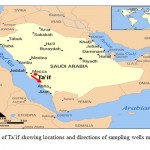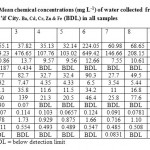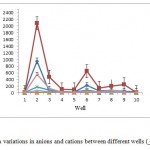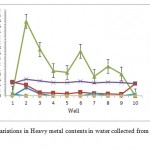Assessment of Mineral Composition of Irrigated Water from Different Wells Around Ta’if City, Saudi Arabia
Huda A. Qari1 *
DOI: http://dx.doi.org/10.12944/CWE.10.1.06
Copy the following to cite this article:
Qari H. A. Assessment of Mineral Composition of Irrigated Water from Different Wells Around Ta’if City, Saudi Arabia. Curr World Environ 2015;10(1) DOI:http://dx.doi.org/10.12944/CWE.10.1.06
Copy the following to cite this URL:
Qari H. A. Assessment of Mineral Composition of Irrigated Water from Different Wells Around Ta’if City, Saudi Arabia. Curr World Environ 2015;10(1). Available from: http://www.cwejournal.org/?p=8504
Download article (pdf) Citation Manager Publish History
Select type of program for download
| Endnote EndNote format (Mac & Win) | |
| Reference Manager Ris format (Win only) | |
| Procite Ris format (Win only) | |
| Medlars Format | |
| RefWorks Format RefWorks format (Mac & Win) | |
| BibTex Format BibTex format (Mac & Win) |
Article Publishing History
| Received: | 2015-01-26 |
|---|---|
| Accepted: | 2015-02-10 |
Access to adequate water for irrigation is a matter of increasing concern all over the globe especially in arid and semiarid areas.1-4 People are using sewage for irrigation of agricultural land due to scarcity of fresh and underground water.
The growing problem of water shortage has significant negative influence on economic development, human livelihoods, and improving the environment nature throughout the world4. To face the growing demand for irrigation water, non conventional resources are often used.4-6 Clean potable water is a must for our daily life. Drinking water should be pure and free of contaminants to ensure health and wellness.6,7
There are three main types of water source in Saudi Arabia; namely rain, surface and ground (well) water.8 The later generally less expensive to develop for use, and usually provides a more certain supply. It is generally preferred as a source for municipal and industrial water supplies. Ground water is the most choice in areas where there is no surface water body However, it is often high in mineral contents and may be contaminated by hazardous or toxic materials leaking from landfills, waste treatment sites, or other sources.9
In areas with a shallow freshwater system, groundwater may easily be contaminated from onsite sewage treatment systems which are typically installed less than 1 m above the water table and may be flooded during heavy rains. The discharge of non point source pollution from these systems to shallow groundwater and ultimately to surface waters could be an important source of contamination for estuary environments.10 Despite a need to understand the groundwater quality status and its potential adverse environmental impacts upon the surface water quality, there are insufficient studies that have comprehensively summarized the quality status in this Saudi Arabia. The goals of this study were to characterize the nutrient dynamics in the major wells in Ta’if city to: (1) evaluate the groundwater nutrient contamination (2) determine the site variations of groundwater nutrients, and (3) determine the seasonal variations of groundwater nutrients.
Materials and Methods
Study Location
Ta’if is located south east to Jeddah City (N 21° 15, E 40° 95) 17 meter above sea level. Its population around 1.5 million (Fig. 1).
Water samples were collected from 12 different wells around the city extended 10 km South East (indicated with a red arrow on Fig.1).
 |
Figure 1: Map of Ta’if showing locations and directions of sampling wells marked with red arrow. Click here to View figure |
Elemental Analysis
Water samples were collected in 250 mL plastic containers from the ten wells along the transict in the city. The containers were tightly closed, placed in an ice box (5°C) and then transported to the laboratory where they were then filtered and refrigerated before metal analysis, as described earlier.6,11 The concentration of water soluble inorganic ions (Na+, Mg+2, Ca+2, Fe+2, K+, SO4-2, NH4-2, NO3-1 and Cl-) was determined by ion chromatography (Dionex IC 3000).12 Inductively coupled plasma mass spectrometry (ICP-MS) was applied to determine the concentration of 10 trace elements (P, Pb, B, Al, Zn, Cr, Cd, Ag, Ba, and Cu).13
Statistical Analysis
Analysis of variance (ANOVA) was applied to log-transformed data. Significant differences between means were tested by LSD (Stattgraphics Statistical Package, Plus 5.1, Informer Technologies, Inc., USA).
Results and Discussion
Saudi Arabia faces numerous environmental challenges. The country has very little arable land. Water scarcity is a constant concern, as are the related issues of desertification and creeping sands. The region’s dryness results in frequent dust and sand storms that can cripple transportation. The lack of water bodies poses a continual challenge, as does the depletion of underground water resources. Analytical results show that the concentrations of nutrient constituents and the values of other related parameters varied from location to location as well as from season to season. Table 1 summarizes the mean concentrations of the selected nutrients.
 |
Table1: Mean chemical concentrations (mg L-1) of water collected from different wells in Ta’if City. Ba, Cd, Cr, Zn & Fe (BDL) in all samples Click here to View table |
Anions varied greatly between water sampled collected from different wells. Cl- varied between 955 mg L-1 in well 1 to 32 mg L-1 in well 5. It was higher the EPA standards (200 mg L-1) in water collected from wells 2 and 6. NO3-2 ranged between 2088 mg L-1 in well 2 to 14.6 mg L-1 in well 10, which is much higher that allowed levels by EPA (10 mg L-1). Similarly, NH4 in samples collected from well 2 was higher (10.86 mg L-1) than that collected from well 1 (0.38 mg L-1). SO4-2 was recorded in tow wells only (2 and 3 and) and there was no traces in other wells i.e. below detection limit (BDL) Table 1. SO4-2 was lower than the USEPA Standards of 250 mg L-1 and Saudi standards of 400 mg L-1, while NH4 was relatively higher than standards of 10 mg L-1 in three wells out of the ten wells examined.*BDL = below detection limit Cations also showed similar trend, as they showed maximum in samples collected from some wells and lower concentrations and even BDL in samples collected from others. Na+ exceeded the standard levels (200 mg L-1) in well 2 (560 mg L-1), while others were around and even below the standard level. Similarly Mg+ exceeded the standards of 30 mg L-1 in wells 2, 3 and 6 (71, 35.8 and 34 mg L-1, respectively). However, K+ was lower than EPA standards of 30 mg L-1 in all samples.
Concentrations of Al, B, P and Pb were exceeding permissible limits and International standards, while other trace metals (Fe, Ba, Cd, Cr and Zn) were not detected in all water samples. Al was detected in water collected from well 2 (0.3 mg L-1) and 3 (0.07 mg L-1) which is higher than EPA standard (0.05 mg L-1) (Table 1). While, Pb and B were detected in all water samples. Pb exceeded the standard level of 0 mg L-1 in all well. Moreover, B exceeded the EPA level (0.1 mg L-1) in many wells. Cu was much lower than EPA standards (1.3. mg L-1) in water collected from all wells, its concentration ranged between 0.068 to 0.083 mg L-1. Spatial distribution of water soluble inorganic ions and trace metals is shown in figures 2 and 3, respectively.
 |
Figure 2: Mean variations in anions and cations between different wells ( + 1 SE) Click here to View figure |
It is clear that Well 2 and 10 had the lowest concentrations of water soluble inorganic matter. While, wells 2 and 6 had the highest concentrations. Moreover, Trace metals showed the same trend, as wells 1 and 10 had the lowest concentrations of heavy metals while wells 2 and 6 had the highest ones (Fig 3).
 |
Figure 3: Mean variations in Heavy metal contents in water collected from different wells ( + 1 SE) Click here to View figure |
Wells 2 and 6 were more close to heavy industry and traffic roads than others and this could be the reason why they are more contaminated with trace metals and water soluble inorganic ions and this in agreement with the general view in the literature. Trace metals can cause change in cloth colors and even color removal of, moreover they can remove colors household appliances if present in high concentrations.13 Using water having high concentrations of Cu and Al exceeding the acceptable levels for irrigation can potentially have a toxic effect on plants. EPA standards for Boron were exceeded in the present study and these concentrations are known to cause irritation of skin upon contact. Moreover, Pb was found at concentrations that would pose risk for public health. It could come from flashing on the roofs14
The source of trace metals could be corrosion of household plumbing systems; erosion of natural deposits, while anions and cations could be due to runoff from fertilizer use; leaking from sewage and/or erosion of natural deposits14,15.
It is well known that presence of to traffic or to industrial activities in close proximity to water bodies is main sources elevated contaminants in water. However, these were not found to be important explanatory variables for Fe, Ba, Cd, Cr and Zn in this study. Therefore, there was insufficiently reliable information collected to allow us to draw any firm conclusions.14 Future research is planned to attempt to identify the sources of trace metals.
This study indicated that most of the chemical parameters such as do not fall within the permissible limit. Therefore, currently the related government departments should focus on regular monitoring of groundwater quality. In conclusion, the use of this water could pose a health and/or an environmental risk, especially in regards to the high concentrations of trace metals such as Pb, Al and Cu. These risks need to be addressed if wells are to provide an alternative water source for cities in Saudi Arabia.The qualities of the well water samples were therefore not suitable for human consumption without adequate treatment. Moreover, regular monitoring of groundwater quality, abolishment of unhealthy waste disposal practices and introduction of modern techniques are recommended.
Creating awareness in society about presence of iron in groundwater and its adverse effects should be carried out by municipal corporation authorities and alternative safe irrigation water should be made available to individuals from study area. The presence of trace metals and inorganic ions in groundwater in study area which has prominently socially and economically weaker individuals and thus they may be not in a position to afford expensive water filtration devices, hence, an alternative low cost technology based on adsorption or absorption needs to be developed for removal of these contaminants in groundwater which can be easily adopted by these local inhabitants.11,15
References
- El-Saharty, A. & Hassan, I.A. (2014). Photochemical Purification of wastewater from the Fungicides and Pesticides Using Advanced Oxidation Processes. Australian Journal of Basic and Applied Sciences, 8(1): 434 – 441
- Al Meelebi, T, Ismail, I., Basahi, J. Qari, H.A. Hassan, I.A. (2014). Hazardous of waste water irrigation on quality attributes and contamination of citrus fruits. Bioscience Biotech. Research, 11(1): 89 – 97.
- Qari, H.A. and Hassan, I.A. (2014). Removal of pollutants from waste water using Dunaliella Algae. Biomedical Phrma. J. 7(1):147 – 151.
- Al-Naksh S. A., Sharma, R.J, Agrawal, M.,. Marshall, F.M. (2010). Health risk assessment of heavy metals via dietary intake of foodstuffs from the wastewater irrigated site of a dry tropical area of India. Food and Chemical Toxicology, 48: 611-619. doi:10.1016/j.fct.2009.11.041
- Abandi, G.A., Saqqar, M.M., Shatanawi, M.R., Fayyad, M., Al-Horani, H., 1997. Some environmental problems associated with the use of treated wastewater for irrigation in Jordan. J. Agric. Water Manage, 34, 81–94.
- Al-Lahham, O., El Assi, N.M., Fayyad M. (2003). Impact of treated wastewater irrigation on quality attributes and contamination of tomato fruit. Agricultural Water Management, 61:51–62. doi:10.1016/S0378-3774(02)00173
- Alimuddin, A. (2015). Assessment of groundwater quality in Rajainagar of Bangalore. Current World Environ. 10(1): http://www.cwejournal.org/?p=8199.
- Abdullah, A. S., and Hani, S. F. (2013). Environmental Prevalence of Pathogens in Different Drinking Water Resources in Makkah City (Kingdom of Saudi Arabia). Current World Environ. 8(1): 37-53.
- Wicklein, S. (2004). Evaluation of water quality for two St. Johns River tributaries receiving septic tank effluent, Duval County, Florida. U.S. Geological Survey, Water-Resources Investigations Report 03-4299, USGS, 2010 Levy Avenue, Tallahassee, FL 32301.
- Abdullah, R. S. (2013). Water Pollution and Predominant Hydrochemical Processes of Groundwater of Haddat Ash Sham-Madrakah Area, Makkah Al Mokarramah District, West Central Arabian Shield, Saudi Arabia. Asian Transactions on Basic & Applied Sciences, 3(2), 22 – 28.
- Ouyang, Y & Zhang, J.-E. (2102). Quantification of Shallow Groundwater Nutrient Dynamics in Septic Areas. Water Air Soil Pollut, 223:3181–3193. DOI 10.1007/s11270-012-1100-1
- Hassan, I.A. & Basahi, J.M. (2013). Assessing roadside conditions and vehicular emissions using roadside lettuce plants. Polish J. Environ. Studies, 22 (2). 75 – 81.
- Magyar, M.I., Mitchell, V.G., Ladson, A.R & Diaper, C. (2008). Lead and other heavy metals: common contaminants of rainwater tanks in Melbourne. Water Down Under, 409 – 417.
- Van Metre, P. C. and Mahler, B. J. (2003), The contribution of particles washed from rooftops to contaminant loading to urban streams, Chemosphere, 52 (10), 1727-1741.
- Kamble, R.K. (2014). Iron in groundwater of Chandrapur city, central India. Int. Res. J. Public & Envir. Health, 1 (8), 170-174. http://www.journalissues.org/IRJPEH/







